The Cancer Biological Therapy Market is estimated to be valued at USD 122.8 billion in 2025 and is projected to reach USD 260.2 billion by 2035, registering a compound annual growth rate (CAGR) of 7.8% over the forecast period.
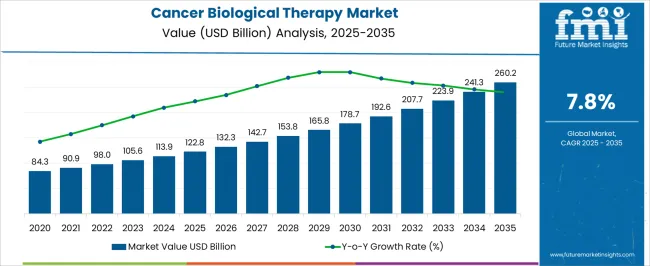
| Metric | Value |
|---|---|
| Cancer Biological Therapy Market Estimated Value in (2025 E) | USD 122.8 billion |
| Cancer Biological Therapy Market Forecast Value in (2035 F) | USD 260.2 billion |
| Forecast CAGR (2025 to 2035) | 7.8% |
The cancer biological therapy market is expanding steadily, supported by the rising incidence of cancer globally and the increasing preference for targeted treatment approaches. Advances in biotechnology and molecular medicine are enabling therapies that stimulate the body’s immune system or directly target cancerous cells, leading to improved efficacy and fewer systemic side effects compared to traditional chemotherapy.
Growing investments in oncology research and development, alongside supportive regulatory pathways for innovative biologics, are accelerating the pace of approvals and market entry. The integration of biomarkers and companion diagnostics is further shaping the adoption of biological therapies, allowing for personalized treatment strategies.
Rising demand for therapies with better safety profiles and long-term disease management benefits is contributing to sustained market momentum As healthcare systems worldwide expand access to advanced cancer treatments and biopharmaceutical companies continue to innovate, the market is positioned to witness consistent growth with strong opportunities in both established and emerging regions.
The cancer biological therapy market is segmented by therapy type, route of administration, cancer type, end user, and geographic regions. By therapy type, cancer biological therapy market is divided into Monoclonal Antibody Therapy, Gene Therapy, Vaccines Therapy, Targeted Drug Therapy, Bio Chemotherapy, Cancer Growth Blockers, and Others. In terms of route of administration, cancer biological therapy market is classified into Intravenous, Subcutaneous, Intrathecal, and Intramuscular. Based on cancer type, cancer biological therapy market is segmented into Lung Cancer, Pancreatic Cancer, Blood Cancer, Colorectal Cancer, and Others. By end user, cancer biological therapy market is segmented into Hospitals, Specialty Clinics, Cancer Research Centres, and Others. Regionally, the cancer biological therapy industry is classified into North America, Latin America, Western Europe, Eastern Europe, Balkan & Baltic Countries, Russia & Belarus, Central Asia, East Asia, South Asia & Pacific, and the Middle East & Africa.
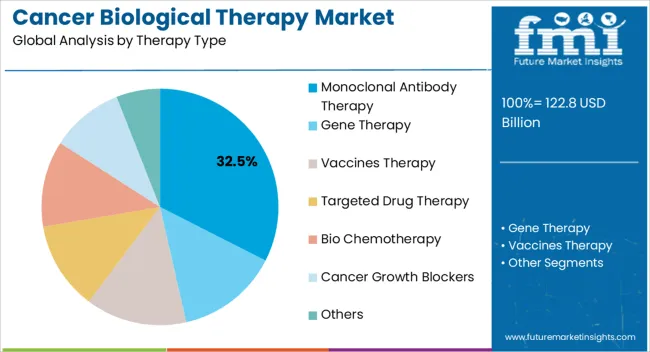
The monoclonal antibody therapy segment is expected to hold 32.5% of the cancer biological therapy market revenue share in 2025, making it the leading therapy type. Its prominence is being supported by the ability of monoclonal antibodies to precisely target cancer cells, thereby reducing damage to healthy tissues and improving patient outcomes. These therapies offer flexibility in application, functioning either as immune checkpoint inhibitors, antibody-drug conjugates, or targeted agents that block cancer growth pathways.
Their proven success in extending survival rates across multiple cancer types has reinforced their adoption by oncologists worldwide. Increasing approvals of monoclonal antibody-based therapies, coupled with expanding research into combination regimens with immunotherapies and chemotherapies, is further accelerating growth.
Manufacturing advancements have improved scalability and reduced production costs, allowing wider accessibility As cancer treatment continues to shift toward precision-based approaches, monoclonal antibodies are expected to remain at the forefront, driving significant clinical and commercial value in the biological therapy landscape.
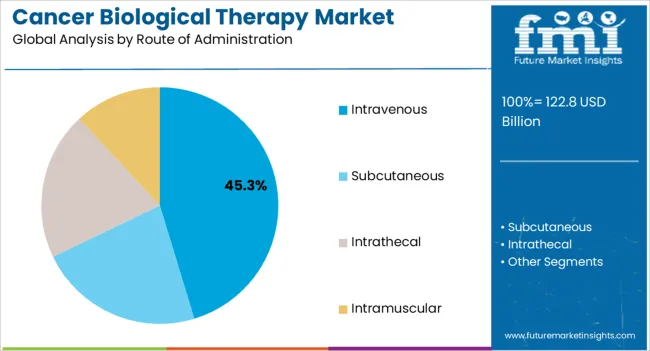
The intravenous route of administration segment is projected to account for 45.3% of the cancer biological therapy market revenue share in 2025, establishing itself as the leading delivery method. This dominance is being attributed to its effectiveness in delivering therapeutic agents directly into the bloodstream, ensuring rapid systemic distribution and precise dosing. Intravenous administration is particularly advantageous for biologics, which often require controlled infusion to maintain stability and therapeutic potency.
Its widespread adoption is being reinforced by established hospital and clinic infrastructure that supports infusion therapies and by the familiarity of healthcare providers with this method. Advances in infusion protocols and supportive care practices have minimized complications, improving patient tolerance and treatment adherence.
The increasing prevalence of biologics requiring large-molecule delivery has further strengthened reliance on intravenous administration As new cancer biologics enter the market with complex molecular structures, intravenous infusion is anticipated to maintain its leadership as the most effective and reliable route of administration.
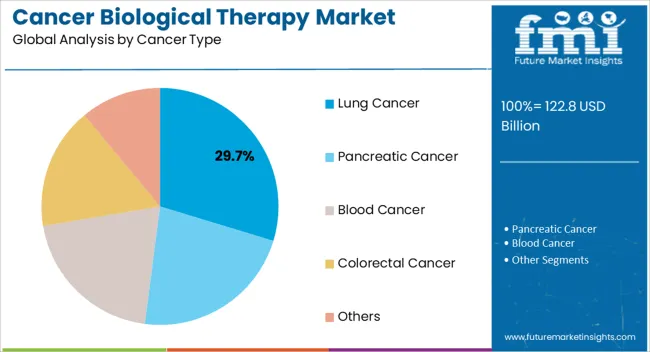
The lung cancer segment is anticipated to represent 29.7% of the cancer biological therapy market revenue share in 2025, making it the dominant cancer type treated with these therapies. This leadership is being reinforced by the high global prevalence of lung cancer and the urgent need for effective treatment solutions in both early-stage and advanced cases.
Biological therapies have demonstrated significant benefits in improving survival rates and quality of life for lung cancer patients, particularly those with specific genetic mutations or biomarker expressions. The segment is further supported by the availability of multiple approved biologics and ongoing clinical trials focused on expanding indications for both non-small cell and small cell lung cancers.
Growing emphasis on early detection, combined with advancements in personalized medicine, is ensuring that biological therapies are increasingly integrated into standard treatment regimens As research continues to identify new molecular targets and optimize treatment combinations, lung cancer is expected to remain the leading cancer indication driving demand for biological therapies.
In the upcoming years, the global market for cancer biological therapies is anticipated to grow at a crucial rate. Effective government policies in developed countries for cancer therapy are the main factor that is projected to drive the global market for cancer biological therapies.
Cancer biological therapy is a sophisticated method of cancer treatment that makes use of a live organism. These life forms are either produced in a lab to cure a cancer infection or obtained from living cells. There are many different kinds of biological treatments, some of which include monoclonal antibodies, interleukins, interferon, and vaccinations. The therapy essentially combats cancer by directly or indirectly making use of the body's immune system. The global market for cancer biological therapy is expected to grow as a result of the rising incidence of cancer cases and the number of specialized cancer treatment facilities around the world.
In economically developed nations, 58% of all newly diagnosed cancer cases happen in patients 65 years of age or older, compared to 40% in developing nations, says globocan. Cancer is the third major cause of mortality in low- and middle-income countries and the second leading cause of death in high-income countries when countries are categorized according to income.
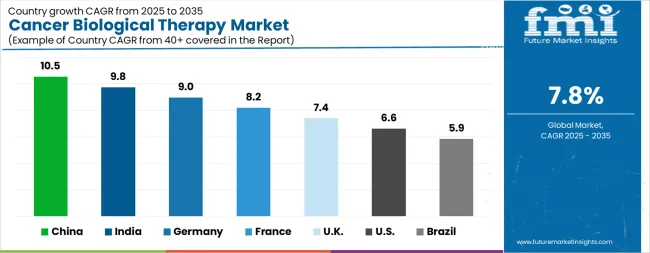
| Country | CAGR |
|---|---|
| China | 10.5% |
| India | 9.8% |
| Germany | 9.0% |
| France | 8.2% |
| UK | 7.4% |
| USA | 6.6% |
| Brazil | 5.9% |
The Cancer Biological Therapy Market is expected to register a CAGR of 7.8% during the forecast period, exhibiting varied country level momentum. China leads with the highest CAGR of 10.5%, followed by India at 9.8%. Developed markets such as Germany, France, and the UK continue to expand steadily, while the USA is likely to grow at consistent rates. Brazil posts the lowest CAGR at 5.9%, yet still underscores a broadly positive trajectory for the global Cancer Biological Therapy Market. In 2024, Germany held a dominant revenue in the Western Europe market and is expected to grow with a CAGR of 9.0%. The USA Cancer Biological Therapy Market is estimated to be valued at USD 42.0 billion in 2025 and is anticipated to reach a valuation of USD 79.8 billion by 2035. Sales are projected to rise at a CAGR of 6.6% over the forecast period between 2025 and 2035. While Japan and South Korea markets are estimated to be valued at USD 5.8 billion and USD 3.8 billion respectively in 2025.
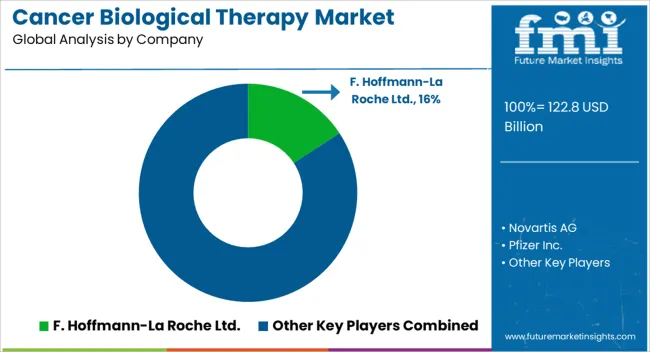
| Item | Value |
|---|---|
| Quantitative Units | USD 122.8 Billion |
| Therapy Type | Monoclonal Antibody Therapy, Gene Therapy, Vaccines Therapy, Targeted Drug Therapy, Bio Chemotherapy, Cancer Growth Blockers, and Others |
| Route of Administration | Intravenous, Subcutaneous, Intrathecal, and Intramuscular |
| Cancer Type | Lung Cancer, Pancreatic Cancer, Blood Cancer, Colorectal Cancer, and Others |
| End User | Hospitals, Specialty Clinics, Cancer Research Centres, and Others |
| Regions Covered | North America, Europe, Asia-Pacific, Latin America, Middle East & Africa |
| Country Covered | United States, Canada, Germany, France, United Kingdom, China, Japan, India, Brazil, South Africa |
| Key Companies Profiled | F. Hoffmann-La Roche Ltd., Novartis AG, Pfizer Inc., Merck & Co., Inc., Sanofi, GSK plc, Lilly, Bayer AG, Teva Pharmaceutical Industries Ltd., Mylan N.V, and Sun Pharmaceutical Industries |
The global cancer biological therapy market is estimated to be valued at USD 122.8 billion in 2025.
The market size for the cancer biological therapy market is projected to reach USD 260.2 billion by 2035.
The cancer biological therapy market is expected to grow at a 7.8% CAGR between 2025 and 2035.
The key product types in cancer biological therapy market are monoclonal antibody therapy, gene therapy, vaccines therapy, targeted drug therapy, bio chemotherapy, cancer growth blockers and others.
In terms of route of administration, intravenous segment to command 45.3% share in the cancer biological therapy market in 2025.






Full Research Suite comprises of:
Market outlook & trends analysis
Interviews & case studies
Strategic recommendations
Vendor profiles & capabilities analysis
5-year forecasts
8 regions and 60+ country-level data splits
Market segment data splits
12 months of continuous data updates
DELIVERED AS:
PDF EXCEL ONLINE
Cancer Registry Software Market Size and Share Forecast Outlook 2025 to 2035
Cancer Diagnostics Market Analysis - Size, Share and Forecast 2025 to 2035
Cancer Biopsy Market - Growth & Technological Innovations 2025 to 2035
Cancer Vaccines Market Analysis by Technology, Treatment Method, Application and Region from 2025 to 2035
Cancer-focused Genetic Testing Service Market Analysis – Growth & Industry Insights 2024-2034
Cancer Tissue Diagnostic Market Trends – Growth & Industry Forecast 2024-2034
Cancer Supportive Care Products Market Trends – Growth & Forecast 2020-2030
Cancer Antigens Market
Cancer Gene Therapy Market Overview – Trends & Future Outlook 2024-2034
Pet Cancer Therapeutics Market Insights - Growth & Forecast 2024 to 2034
Skin Cancer Detection Devices Market Size and Share Forecast Outlook 2025 to 2035
Lung Cancer Diagnostics Market Size and Share Forecast Outlook 2025 to 2035
Lung Cancer Surgery Market - Size, Share, and Forecast 2025 to 2035
Lung Cancer Therapeutics Market Analysis – Size, Share, and Forecast Outlook 2025 to 2035
Lung Cancer PCR Panel Market Trends, Growth, Demand & Forecast 2025 to 2035
Brain Cancer Diagnostics Market Size and Share Forecast Outlook 2025 to 2035
Liver Cancer Diagnostics Market Size and Share Forecast Outlook 2025 to 2035
Blood Cancer Treatment Market Growth – Trends & Forecast 2025 to 2035
Breast Cancer Grading Tools Market Size and Share Forecast Outlook 2025 to 2035
Breast Cancer Screening Tests Market Size and Share Forecast Outlook 2025 to 2035

Thank you!
You will receive an email from our Business Development Manager. Please be sure to check your SPAM/JUNK folder too.
Chat With
MaRIA